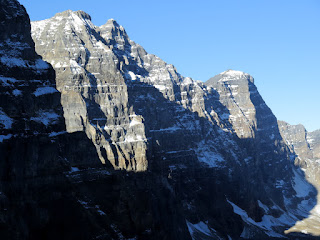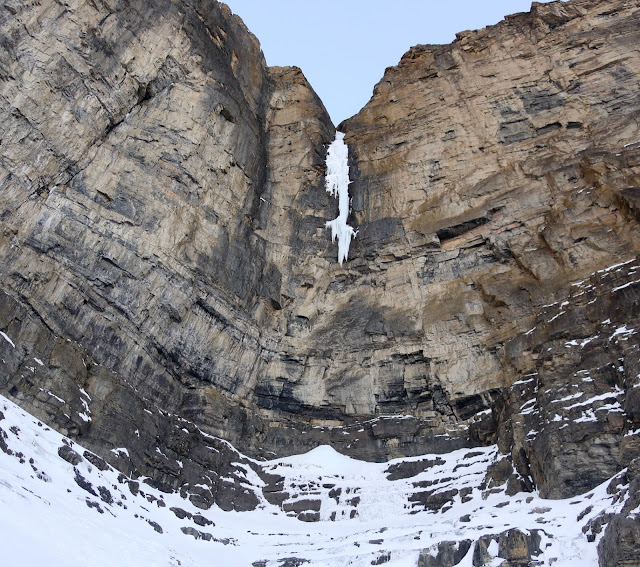Before The Snow Flies
The crunch of shoes on frozen mud in the morning; yellow aspen leaves fluttering to the ground; and warm afternoon sunshine on rough limestone. But also: north faces dusted with fresh snow; dripping water stilled into icicles by nights growing longer and colder; and bright larches on the valley floor far below.
October in the Rockies presents altogether too many choices. For years, I used to spend it chasing one last summery adventure on sunny summits, or the first wintry one in shaded couloirs. But more recently, a growing obsession with rock gymnastics saw me spending my Octobers chasing this or that elusive redpoint, until the days grew just too short, too grey and too miserable to contemplate bare-handed crimping. When I'd finally trade sticky rubber for crampons, I'd realize it was November, and that deep snow and winter cold had already come to the high country. And so I'd tell myself that, the following year, I wouldn't miss that bittersweet interlude between summer and winter in mountains. But then another October would roll around, and there'd still be unfinished business at The Coliseum... So this October, even though the weather for much of the month was mild and sunny - perfect rock climbing weather - on a few occasions I did pack my ice tools instead of rock shoes, and set the alarm for four in the morning.
Mt. Fay
The road to Moraine Lake was closing in few days. With that looming deadline, and the threat of snow in the forecast, Juan and I made plans to run up the north face of Mt. Fay. Well, to say "run" might be an exaggeration - after a summer spent rock climbing, neither one of us would be mistaken for Killian Jornet.
Our timing with the season was impeccable, as the trail and the rock on the Perren approach were both dry. It wasn't until we hit the glacier below the face that we were faced with anything resembling trail breaking.
We opted for the seracs of the Chouinard route on the left side of the face. The wave of glacial ice halfway up the route had been made famous by photos in Jeff Lowe's Ice World, and it seemed like an apt place to swing tools for the first time of the season.
From the cold, blue shade of the face, we looked out at sun-drenched screes and forests, still bare of snow for another few days. Photo: Juan Henriquez.
We avoided the overhanging ice in the centre and opted for the merely vertical terrain on the right. Even so, it wasn't hero ice, this serac stuff, with dinner plates exploding from every tool placement. Photo: Juan Henriquez.
Higher up, the ice did change consistency to something resembling meringue - not so good for protection, but great for climbing.
Within the space of a bodylength, we emerged from the cold shade of the face into the warmth of a windless afternoon. Without a cloud in the sky and with the forest fires extinguished by autumn rains, we could see all the way from the front ranges in the east to the Bugaboos in the west.
Tired but satisfied, we plunged back down to the valley. To our surprise, it appeared we'd actually make it home for dinner.
The Fist
For years, every time I drove down the Smith-Dorrien Trail in the fall, my eyes would be drawn to the squat shape of the The Fist. My imagination filled the dark gash in its northeast face with ice, but reality, as seen through binoculars, appeared to be the usual Rockies fare of loose snow over dry rock.
It didn't help that those who ventured for a closer look came back with tales of unprotectable, compact rock. Tellingly, none of them returned for another go. But in the middle of the month, with the weather too crappy for rock but still too warm for ice, Alik and I decided to finally make up our own minds about the infamous - if obscure - gash.
With the aforementioned compact rock in mind, we came armed with technology to tame excessive runouts. Imagine our shame when we topped out on the first pitch only to find an old gear anchor. We consoled ourselves with the thought that, whoever had left it, probably enjoyed at least a smattering of ice where we scratched up rock and moss. That, or they had bigger cojones.
On our first attempt we were joined by Nik Mirhashemi from Alpine Mentors. Strangely, he declined to join us on the next go, preferring to drive down to Indian Creek instead. There's no accounting for taste.
The second pitch started out overhanging, but bomber hooks and gear made for moderate climbing. After a few bodylengths, the rock petered out into a fat snow ledge below the upper chimney. Photo: Nik Mirhashemi.
And the chimney looked far better than expected - which perhaps said more about our low expectations than the quality of said chimney.
Be that as it may, it gave excellent climbing on blocky but not loose rock. Granted, there wasn't a lick of ice anywhere, but the snowed up rock with the occasional bit of turf had a downright Scottish flavour. Well, maybe except for the bolts.
For once, pitches that had looked desperate from below proved easier than expected on closer acquaintance. And how often does that happen? Photo: Alik Berg.
Higher up, we entered the guts of the gash, in places climbing in the twilight under giant chockstones.
The only thing that detracted somewhat from the enjoyment was the haulbag full of hardware we'd brought expecting a epic struggle, but never used.
The westerlies howled overhead, occasionally sending clouds of spindrift down the gash. In its depths, though, we stayed reasonably sheltered. And at least we didn't have a loaded snow slope overhead.
We topped out from the gully just in time to enjoy the last rays of the sun, setting over the early-winter Rockies. Like alpinists of old, we didn't immediately start down the other side, but scrambled up to the summit proper. It helped that it was only five minutes away. The headlamps didn't come out until we'd returned to our packs at the base.
























Comments
Post a Comment